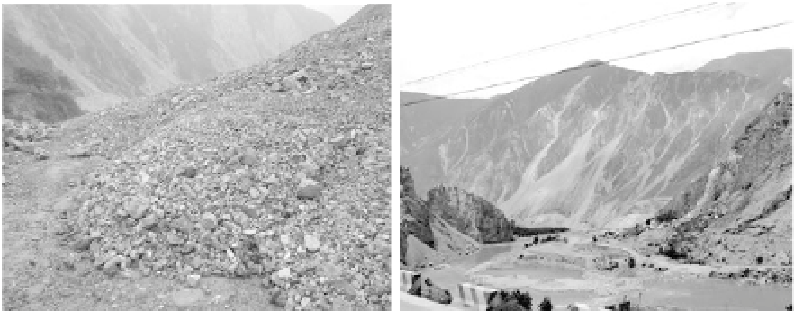Environmental Engineering Reference
In-Depth Information
(a) (b)
Fig. 2.12
(a) A slope debris flow sediment deposit on the highway along the Mianyuan River; (b) Grain erosion
deposit causing local sedimentation in the Minjiang River
Grain erosion occurs as a result of expansion and contraction due to temperature change and
breakdown of rocks under the action of sunshine. The new bare rocks are very vulnerable to erosion.
Without the protection of vegetation cover or a layer of soil on the surface, bare rocks are acted on by the
radiation from the sun and temperature change. The exposure to weathering and the cycle of expansion
during the day and contraction in the night causes fissures and breaks down the rocks. Figure 2.13(a) shows
cracking bare limestone due to exposure to weathering and temperature change along the Mianyuan River.
The limestone is fragile and a surface layer about 10 cm thick was broken. The surface layer of the rock is
further broken down into grains. Wind or tremors caused the grains to roll down the slope. Figure 2.13(b)
shows a layer of grain erosion deposit covering an avalanche deposit fan along the Minjiang River near
Wenchuan. The grain erosion occurred on granite rock and the grains are generally finer than the grains
in limestone areas. The grains are very uniform in size with a median diameter of about 1 cm. As a
comparison the avalanche deposit beneath the grain layer is much more non-uniform consisting of stones
of several meters and fine particles less than 1 mm. Because the grains from grain erosion are uniform in
size and regular in shape people have mined the grains for building materials at some grain erosion sites
with access to transportation facilities.
(a) (b)
Fig. 2.13
(a) Bared limestone is cracked and broken down due to insolation and temperature change; (b) A layer of
grain erosion deposit covered on an avalanche deposit fan on the Minjiang River near Wenchuan








Search WWH ::

Custom Search